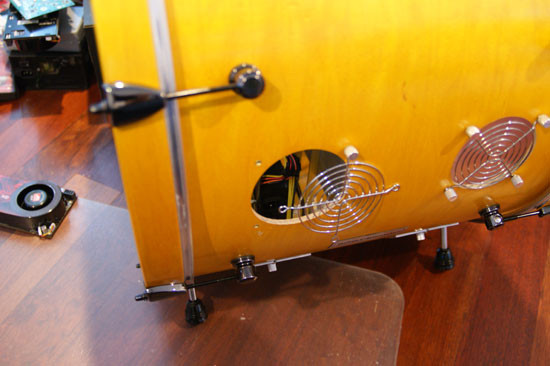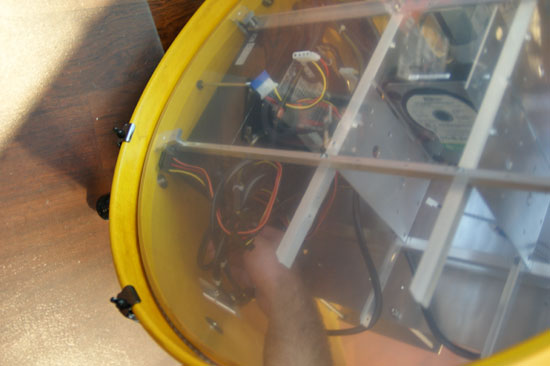Spotswood Custom Computer Cases
by Derek Wilson on August 27, 2008 12:00 AM EST- Posted in
- Cases/Cooling/PSUs
Notes on Cooling
This case isn't designed with conventional airflow in mind. Normally we want airflow directed in from the front and out of the back of a case, passing over the components inside. The main exhaust for this system is meant to be the top (which isn't a bad idea: heat does rise anyway), but the orientation of the board is wrong for optimal airflow over the components. Additional fan mounts are on the back and side, but there's no mount or intake on the front (though you can probably have one added by request). You can also reverse fan direction as you see fit, but you'll want to avoid creating extra turbulence so adding intake fans on the bottom makes the most sense.
In reality, this case is meant for water-cooling everything - and we mean everything. The system comes with mounting brackets to attach a radiator to the 120mm fans at the top exhaust port, offering quite a bit of airflow and room for a nice large radiator. This is a good design for a water-cooling system, and definitely the best way to go in terms of cooling the system inside.
It is possible to attach fans and radiators to the rear and bottom fan portals as well, but we would recommend adding an intake portal to at least one of the side panels if you plan to mount three internal radiators. Actually, leaving at least one of the rear fan portals free will help out a lot, as there is no easy way to reach the rear panel on the mobo, the PSU hard power switch, or any other cables going into the system from the back. Of course, if you leave one of these rear fan portals free, you can just take out three thumbscrews and reach right into the system to do whatever you need.


Our recommendation on cooling a system configured like ours (i.e. without water-cooling) is to use the bottom fan portals for intake (with intake fans) and use the top and rear for exhaust. The rear exhaust nearest the expansion slots on the mobo will be important if you are not water-cooling your graphics card, as you will want something to direct the air from the graphics card away from the rest of the system - normally, high-end GPUs vent directly out of the case, but this design prevents that. Water-cooling everything (including the graphics card(s)) with two radiators and intake fans on the bottom is probably the best option.
The one chink in the armor is that the PSU will still exhaust into the case in an area that is not near any fan portals and happens to be right under the hard drive array area. I've had more than one hard drive die via overheating, so I would look at adding some internal fans to move air around the drives as well. A solution might be a small exhaust portal on the front near the bottom
With an enthusiast system inside, properly cooled, this will not be a quiet computer. Of course, you could go another way and just attach an industrial fan to the front or back and create a wind tunnel across the system. Yeah, that might work...










36 Comments
View All Comments
Spotswood - Wednesday, August 27, 2008 - link
As the President, builder and designer, I have a responsibility to clarify a few points in this review that are inaccurate, misrepresented or not at all addressed. I offer the following facts and information.- The two rear ports aren't meant for mounting case fans, rather they are there to access the inside of the case without having to remove a side panel/head.
- The hardware to convert the C-24 to an L-24 was provided to the author solely for the purpose of not having to supply two separate cases for review. An L-24 case normally has all of the hardware already attached to it.
- The mounting position of the motherboard tray is adjustable. The issues with the length of the PSU cables would have been eliminated if the author mounted the motherboard tray lower and more toward the front of the case. The instruction manual explicitly details the adjust-ability of the motherboard mounting.
- In the future, the motherboard tray will be revised with large holes to help facilitate routing cables from behind and underneath the motherboard itself.
- The case supplied for the review was built to have airflow move from the bottom to the top. However, when placing an order the customer is free to choose the total number of case fans (0-9), there location, along with the make and model.
- The three fans supplied with this particular case were SCYTHE S-FLEX™ 1200rpm fans (SFF21E). These fans are highly regarded by enthusiasts for there high CFM and low noise.
- The author failed to present any temperature or noise measurements prior to offering a series of solutions to perceived problems with cooling and noise.
- The case was built to be reviewed as a water-cooled case. A complete CPU water-cooling rig (D-Tek Fusion waterblock, Swiftech MCP655 pump, ThermoChill PA120.3 radiator, etc.) was supplied to the author for the sole purpose of this review.
Richard Chomiczewski, President
Spotswood Custom Computers, Inc.
cggkevin - Wednesday, August 27, 2008 - link
A better deal would be to go to a pawn shop and pick up a drum set for a couple of hundred and then just set a real PC case inside. This is kinda like a non-mini mini-ITC project.MagnumMan - Wednesday, August 27, 2008 - link
So basically they've tried to put a square peg in a round hole, on stands. Yuck.KIAman - Wednesday, August 27, 2008 - link
LOL, people have forgotten that style AND good performance should be considered in a case design.Drums? Come on, where's the creativity? I can brainstorm about 4 other designs without blinking.
1. Empty 5 gallon Aquafina jug
2. 1/8 scale model of Hummer
3. A 1 foot radius Earth globe
4. Toy model castle
mikeblas - Wednesday, August 27, 2008 - link
"(think oil rather than musical)"Are you sure? Because it looks way more like a musical drum than an oil drum, to me. And the review even says it's designed to look like a kick bass. Who edited this? Were they awake?
strikeback03 - Wednesday, August 27, 2008 - link
To me the article was not the most clear on the difference between C and L series cases, but as far as I could tell the C series are cylindrical but just have plain endcaps, not the drumheads and hardware. So sitting with the cylinder axis vertically and no bass drum hardware, it does sort of resemble a sawed-off oil barrel.Spacecomber - Wednesday, August 27, 2008 - link
I've always been skeptical about case designs, such as acrylic cases, that lack a metal exterior that can act as shield against the computer radiating electrical interference. This seems like it might be a particular concern in an environment where you are using analog audio equipment, such as in home theater, music server and music recording applications.While that's the theory, does anyone have some practical experience with regard to this potential problem?
wisfal - Wednesday, August 27, 2008 - link
I think that the style and uniqueness of the case is pretty good, I never thought of turning my drum kit into a computer case. I would go great for anyone with a music oriented room. But for a price like that, I could go to a pawn shop and Home Depot and build 10 of them for the price of one.Spivonious - Wednesday, August 27, 2008 - link
That is really cool! It reminds of the days when people were making cases out of chairs, tables, books, and anything else they could get their hands on. I imagine that it blends in nicely with the other instruments in your dining room.ChrisPL - Wednesday, August 27, 2008 - link
These "cases" are the most retarded thing I've ever seen... Waiting for a case made on a basis of refrigerator chasis...